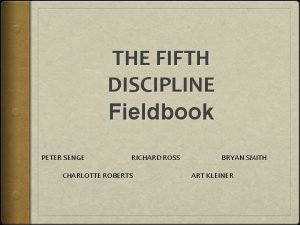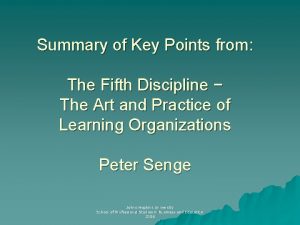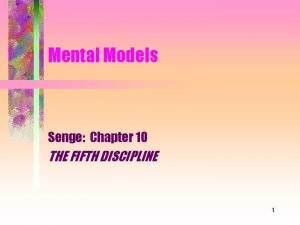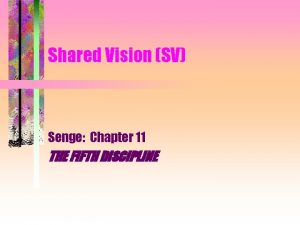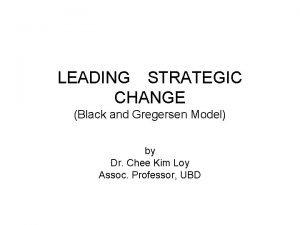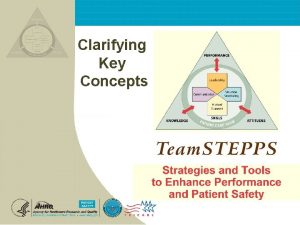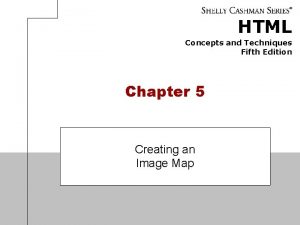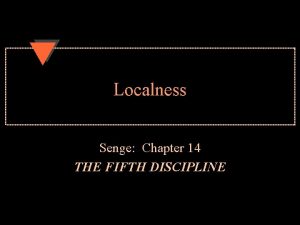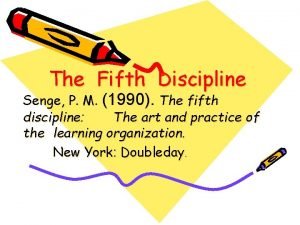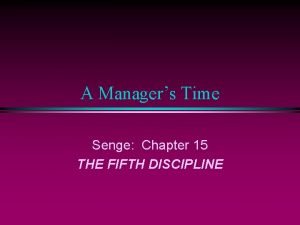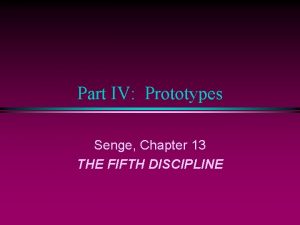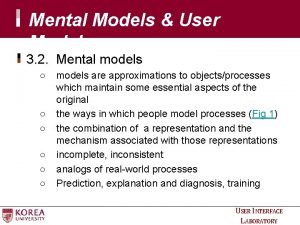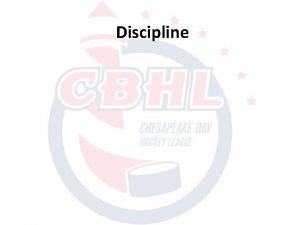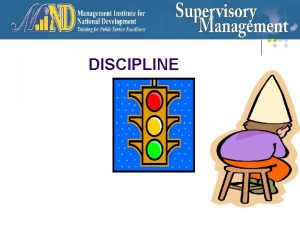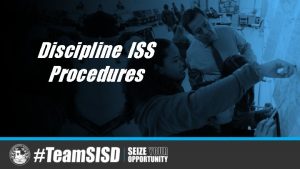Mental Models Senge Chapter 10 THE FIFTH DISCIPLINE


































- Slides: 34

Mental Models Senge: Chapter 10 THE FIFTH DISCIPLINE 1

What are Mental Models? • The mental constructs that dictate – the decisions that we take – the actions that we engage in • The Second of Five Disciplines – Who remembers the other four? 2 -19 -00 Prepared by James R. Burns 2

What’s the Problem? • Many of the best ideas never get put into practice – Why? ? ? – Because they conflict with deeply held internal images of how the world works – These images limit us to familiar ways of thinking and acting • We keep making the same mistakes over and over again--we’re not learning 2 -19 -00 Prepared by James R. Burns 3

The discipline of Mental Models (MMs) Involves • Surfacing these models • Testing these models • Improving our internal pictures of how the world works • PROMISES TO BE A MAJOR BREAKTHROUGH FOR BUILDING LEARNING ORGANIZATIONS 2 -19 -00 Prepared by James R. Burns 4

Why are MMs so powerful in affecting what we do? • They affect what we see – They become the cognitive lense through which we view the world – Two people with different MMs can see the same situation and describe it differently – Big three auto-makers believed Americans bought cars on the basis of styling – Today outdated MMs dominate the service industries, which still provide mediocre quality in the name of controlling costs 2 -19 -00 Prepared by James R. Burns 5

So the Problem arises when our mental model is wrong…RIGHT? • WRONG!!! • The problem with mental models is that they are tacit--below the level of awareness • We don’t realize that our behavior is being dictated by a certain mental model that we have bought into deeply 2 -19 -00 Prepared by James R. Burns 6

A Digression and Break • Arm Wrestling • Good Exercise • Good way to break up a boring session on mental models • Find an opponent • The contestant who can defeat his opponent the most times in one minute wins. 2 -19 -00 Prepared by James R. Burns 7

An Industrial Goods Manufacturer • Was losing market share • Production managers held inventories as low as possible • Result was long lead times, long delivery times even though production capacity was adequate • A team of MIT system dynamicists were brought in 2 -19 -00 Prepared by James R. Burns 8

What did the models show? • Low inventories meant long lead times • Why not carry some inventory • They did this for a while and it worked – The firm’s market share picked up • But the new policies were not taken to heart • Four years later when another recession occurred, the firm went back to their original low inventories and began losing market share again 2 -19 -00 Prepared by James R. Burns 9

Why did they do this? • The inertia of deeply entrenched mental models can overwhelm even the best systemic insights 2 -19 -00 Prepared by James R. Burns 10

Shell--one of the first firms to investigate MMs • Is broken up into over a hundred companies • Must continually challenge the leaders of these firms to scrutinize their MMs 2 -19 -00 Prepared by James R. Burns 11

Overcoming the basic diseases of the hierarchy • For hierarchical organizations the dogma is “manage, organize, control” • For learning organizations, the dogma is vision, values, and MMs • Healthy firms are ones that bring people together to develop the best possible MMs for facing any situation at hand 2 -19 -00 Prepared by James R. Burns 12

The Experience at HANOVER • Hanover--an insurance carrier (a property and casualty insurance firm) • Hanover hired consultant Chris Argyris. He brought in his “ACTION SCIENCE” • Argyris: “Because we insulate our mental models from examination, we develop ‘SKILLED INCOMPETENCE. . ’” • Recall a conflict with a client--what did you say--what did you think, what did you not say 2 -19 -00 Prepared by James R. Burns 13

Left-Hand Column Analysis – The left-hand column details what you were thinking – The right-hand column details what was actually said • Sample case: Jim is an R&D project manager. Jim assumes his supervisor Todd feels harshly about him. Jim just had a conversation with Todd. Jim writes out the conversation with Todd in the right-hand column and his thoughts at the time in the left. 2 -19 -00 Prepared by James R. Burns 14

• TODD: Jim, I’d like to come down there next week. We’re a few • We’re two months late and I don’t think he knew. I was weeks behind, and I think we hoping we could catch up might all benefit from a meeting at your office. • I need to make it clear that I’m willing to take responsibility • ME: I’ve been very concerned for this, but I don’t want to about these deadlines. As you volunteer for more work know, we’ve had some tough luck here, and we’re working • He never offers this help in the around the clock. But of course, planning stages, when I could we’ll squeeze in a meeting at really use it. It’s too late now to your convenience. bring that up. • TODD: Well, its occurred to me • The changes he keeps making that we could use better are the real reason we’re late. coordination. There are some He must have another one. ways I could help. • It’s a shame I can’t tell him that he’s the cause of the delays. If I • ME: Well, I’m happy to talk through any changes you have can hold him off two more in mind. weeks, I think we’ll be ready. • TODD: I don’t have anything 2 -19 -00 Prepared by James R. Burns 15 specific in mind

What can you do with this? • You can learn a lot about how your responses could have been better, more to the point. • You can also ask yourself what has really led me to think and feel this way? • What was my intention? What was I trying to accomplish? • Did I achieve the results I intended? • Did my comments contribute to the difficulties 2 -19 -00 Prepared by James R. Burns 16

When we examine our mental models… • Each of us has contributed to a conflict through our own thinking • We made sweeping generalizations about others that determined what we said and how we behaved • We are led to see subtle patterns of reasoning which determines our behavior and how these continually got us into 2 -19 -00 Prepared by James R. Burns trouble 17

Hanover & Argyris’s Colleague Lee Bolman • Bolman further exposed Hanover’s managers to the ideas and practices of action science • Be a good inquirer • Balance inquiry with advocacy • Understand that all we ever have are assumptions, never “truths, ” that we always see the world through our mental models and that the mental models are always incomplete and in Western culture, non-systemic 2 -19 -00 Prepared by James R. Burns 18

Hanover Bottom Line Results • Over a 15 year period, Hanover got better and better at its margins and market share • Its average return was 21. 8% where the industry average was 15. 9 percent • Today, Hanover continues to build a foundation of basic skills in reflection, surfacing and public examination of mental models 2 -19 -00 Prepared by James R. Burns 19

Hanover’s Strategy • Recognize “leaps of abstraction” – Jumps from observation to generalization • Exposing the “left-hand column” • Balance inquiry and advocacy • Facing up to distinctions between espoused theories (what we say) and theories in use (what we do as determined by our MMs) 2 -19 -00 Prepared by James R. Burns 20

The Discipline of Mental Models • Bring key assumptions about important business issues to the surface – Who remembers the Goldratt mechanism for doing just this? • Without surfacing these assumptions, an organization’s range of actions are limited to what is familiar and comfortable • Develop face-to-face learning skills 2 -19 -00 Prepared by James R. Burns 21

The Discipline of MMs, Continued • Both sides of the discipline--business skills and interpersonal issues--are crucial • Without interpersonal skills, learning is still fundamentally adaptive, not generative • Generative learning requires managers with reflection and inquiry skills, not just consultants and planners 2 -19 -00 Prepared by James R. Burns 22

Planning as Learning and Internal Boards: Managing Mental models Throughout an Organization • Firms need to put in place mechanisms that make the practices of reflection and surfacing mental models unavoidable • How? By recasting traditional planning as learning and establishing “internal boards of directors” to bring senior management and local management together • How? By using SCENARIOS in the case of 2 -19 -00 Prepared by James R. Burns 23 Shell

More ways to surface mental models • Use tools for mapping mental models--Shell. These include systems thinking tools like the archetypes, as well as the computer simulation capabilities of a tool like VENSIM • Microworlds and numerous other “soft systems” tools are also used 2 -19 -00 Prepared by James R. Burns 24

What is the common denominator of these tools? • They work to expose assumptions about important business issues • The basic idea is to institutionalize managing mental models through the planning process 2 -19 -00 Prepared by James R. Burns 25

Hanover also uses internal boards • Composed of two to four senior managers and local general managers • Senior managers are not allowed to impose their mental models on local managers • Hanover developed a Credo on Mental Models 2 -19 -00 Prepared by James R. Burns 26

Hanover’s Credo • The effectiveness of a leader is related to the continual improvement of the leader’s mental models • Don’t impose a favored mental model on people • Self-concluding decisions result in deeper convictions and more effective implementation • Better mental models enable owners to adjust to change in environment or circumstance • Internal board members rarely need to make direct decisions 2 -19 -00 Prepared by James R. Burns 27

Hanover’s Credo, Continued • Multiple mental models bring multiple perspectives • Groups add dynamics and knowledge beyond what one person can do alone • The goal is not congruency among the group • When the process works it leads to congruency • The leaders’ worth is measured by their contribution to others’ MMs 2 -19 -00 Prepared by James R. Burns 28

Reflection and Inquiry Skills: Managing Mental Models at Personal and Interpersonal Levels • Reflection skills concern becoming more aware of how we form our mental models and the ways they influence our actions • Inquiry skills concern how we operate in face-to-face interactions with others 2 -19 -00 Prepared by James R. Burns 29

Reflection Skills • Recognize leaps of abstraction • Miller’s 7 plus/minus 2 rule • Untested models of customer behavior are often leaps of abstraction • To surface leaps of abstraction, ask “What do I believe about how the world works? ” • Then ask, “Is this generalization inaccurate or misleading? ” 2 -19 -00 Prepared by James R. Burns 30

Reflection Skills • Where possible test the generalizations directly 2 -19 -00 Prepared by James R. Burns 31

Inquiry skills • Use left-hand, right-hand column analysis • In conflicts, avoid the systems archetype of escalation 2 -19 -00 Prepared by James R. Burns 32

Mental Models and The Fifth Discipline: Systems Thinking • The two disciplines go hand-in-hand • ST without MM is like an airplane without wing flaps 2 -19 -00 Prepared by James R. Burns 33

Copyright C 2000 by James R. Burns • All rights reserved world-wide. CLEAR Project Steering Committee members have a right to use these slides in their presentations. However, they do not have the right to remove this copyright or to remove the “prepared by…. ” footnote that appears at the bottom of each slide. 2 -19 -00 Prepared by James R. Burns 34
 La quinta disciplina the fifth discipline fieldbook
La quinta disciplina the fifth discipline fieldbook The harder you push the harder the system pushes back
The harder you push the harder the system pushes back Mental models peter senge
Mental models peter senge The fifth discipline summary
The fifth discipline summary Fifth discipline
Fifth discipline Chapter 20 mental health and mental illness
Chapter 20 mental health and mental illness Personal mastery definition
Personal mastery definition Quinta disciplina peter senge
Quinta disciplina peter senge Team learning peter senge
Team learning peter senge Bariatriske senge
Bariatriske senge Senge shared vision
Senge shared vision Dominio personal peter senge
Dominio personal peter senge La quinta disciplina
La quinta disciplina Hasten senge
Hasten senge The illusion of taking charge examples
The illusion of taking charge examples Peter m. senge aportaciones a la calidad
Peter m. senge aportaciones a la calidad Difference between modals and semi modals
Difference between modals and semi modals Strategic change matrix
Strategic change matrix Ipassthebaton
Ipassthebaton Mental health coping skills jeopardy
Mental health coping skills jeopardy Fifth chapter menu
Fifth chapter menu Hát kết hợp bộ gõ cơ thể
Hát kết hợp bộ gõ cơ thể Lp html
Lp html Bổ thể
Bổ thể Tỉ lệ cơ thể trẻ em
Tỉ lệ cơ thể trẻ em Gấu đi như thế nào
Gấu đi như thế nào Tư thế worms-breton
Tư thế worms-breton Bài hát chúa yêu trần thế alleluia
Bài hát chúa yêu trần thế alleluia Môn thể thao bắt đầu bằng từ chạy
Môn thể thao bắt đầu bằng từ chạy Thế nào là hệ số cao nhất
Thế nào là hệ số cao nhất Các châu lục và đại dương trên thế giới
Các châu lục và đại dương trên thế giới Công của trọng lực
Công của trọng lực Trời xanh đây là của chúng ta thể thơ
Trời xanh đây là của chúng ta thể thơ Cách giải mật thư tọa độ
Cách giải mật thư tọa độ Phép trừ bù
Phép trừ bù
